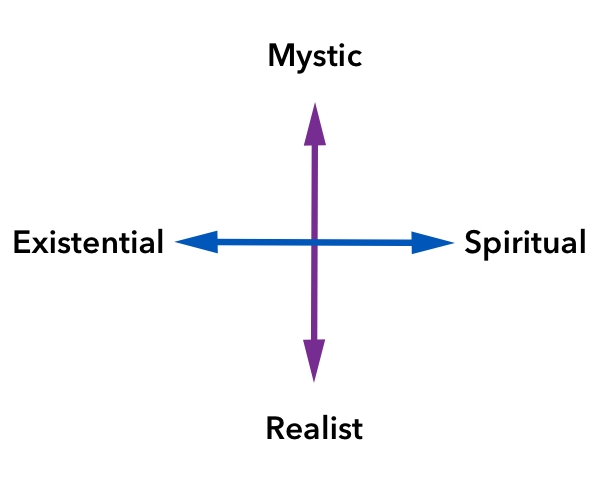Now we have our two axes:

The EXISTENTIAL <—> SPIRITUAL axis defines the individual’s inclination to grant woo an independent reality, the approach to woo. The REALIST <—> MYSTIC scale defines the individual’s willingness to experience or interpret an event as woo, or the response to woo.
You might suppose that all Realists would be Existential and all Mystics would be Spiritual, but that is—oddly—not the case. Although we will first examine the two obvious combinations, my four subjects actually represent the four possible combinations of the two axes.
Let us suppose that our four subjects, having gone to the wellspring of American New Age Woo, Sedona, AZ, have decided to pop in to the Center for the New Age and see what kind of woo they can experience.[1] The CNA offers a rather complete range of woo: besides the store full of crystals, candles, occult objects, books, and tarot decks, they have a large staff of trained specialists who can give you tarot readings, crystal work, aura readings, past life regressions, chakra balancing, and other psychic guidance.
At the main counter, you can flip through a notebook with the vitae of the psychics on duty and book your session there. Given our two scales of approach and response, we can expect different reactions to the situation.
The Existential Realist
The Existential Realist neither thinks woo is real nor is willing to acknowledge that he has experienced any such thing. In the CNA, he may browse the shelves and may even find a book that interests him, but the crystals are just pretty rocks and the candles smell.
If he’s an asshole, he may openly disparage the shop and its denizens. If he’s nicer than that, he may decline to book a session or evade the topic altogether. If he decides to enter into the spirit of the thing, he will politely endure the ministrations of the chakra balancer, but he will feel nothing and will chalk it all up to being a good sport.
The Spiritual Mystic
The Spiritual Mystic, on the other hand, feels acutely the spiritual nature of the place. In fact, he may be overwhelmed by it, or react negatively to this particular location’s vibe and seek his woo experience some place more simpatico.
If he decides to book a session, he will select a practitioner exactly as the staff has instructed—by using his intuition—poring over each page to see if he feels a connection with the man or woman in the picture. He will listen earnestly to advice from the staff about which service would be best to meet his psychic needs.
Once in the session, he will feel the energy of the room, the practitioner, and the process. The energy will inform his experience, and he will come away from the session feeling very different than when he went in.
The Existential Mystic
Here’s where our model flies in the face of logic but is actually a useful descriptive tool: The Existential Mystic does not think there is anything out there that is worth the name of woo. He can pick up any number of quartz crystals without feeling a single tingle.
However, if in his chakra balancing he sees specific images or feels a warmth/coldness/whatever in one of the chakras, then he is more than willing to acknowledge that he cannot—or does not need to—explain it away. He evaluates it as ineffable and includes it in his spiritual makeup.
The Spiritual Realist
This one is even odder than the Existential Mystic. The Spiritual Realist does believe in God/auras/the Force, but is apt to deny any manifestation of it unless presented with overwhelming evidence.
At the CNA, he glosses over all the items for sale as being irrelevant trinkets, but he does take the time to choose a psychic and book a session. He represses giggles during the chakra balancing, but then turns around and books an additional reading from the psychic, which he finds both impressively accurate and helpful. (He nonetheless inquires about the man’s credentials.) After the reading, he may feel the need to buy a crystal or two.
tl;dr
Faced with woo:
- The Spiritual Mystic says, “I feel it; my [choose one] chakra needs opening.”
- The Spiritual Realist says, “I believe in [choose a woo], but I doubt this is it.”
- The Existential Mystic says, “Honey please, but that one I felt.”
- The Existential Realist says, “Bah! Humbug!”
Next: So what?
—————
[1] Although the four subjects are real people, I am fictionalizing their responses to the experience. I do not presume to know the originals’ innermost thoughts, nor do I claim that how I portray their responses is in any way an accurate representation of them. To further muddy the waters, I am portraying all four subjects as male.
It would be interesting to run the model through an examination of the nature of doubt and certainty. Seems we find certainty at the two approach poles and then various degrees and types of doubt playing about in the middle area, influenced by the nature of encounters, etc. Also, the “inner” business. Can “conversions” occur without external encounters? Does there need to be a Thing out there in time and space to define the encounter? Raises interesting questions…
In other words, is that how “woo” is defined? It’s out there, oh yeah, it’s out there….etc. More woo in the woof than in the warp?
Exactly. I’m trying very hard to make the model agnostic about woo—not successfully, but it’s early in the game—so that it is useful to both ends of the scale in seeking gnosis.